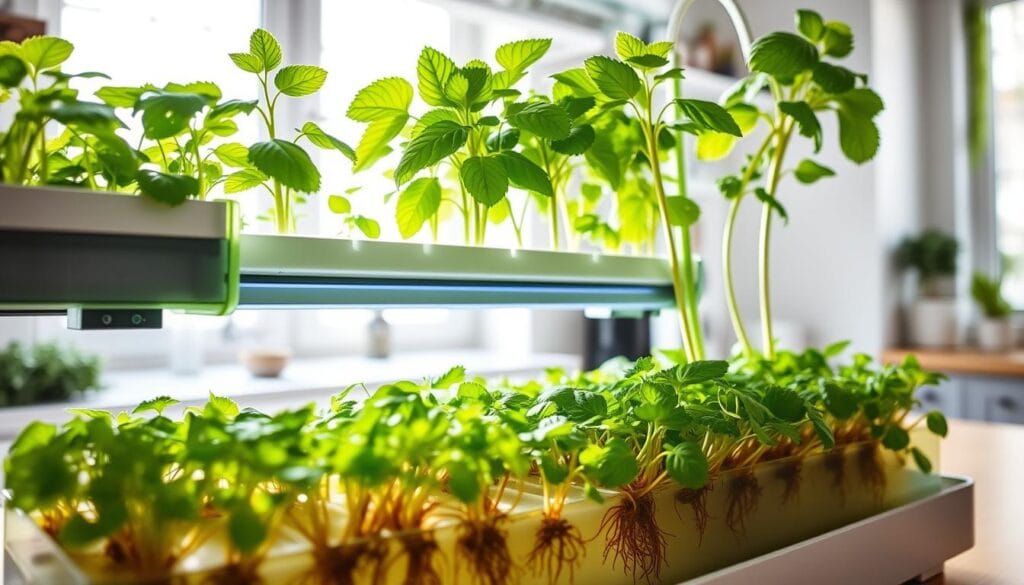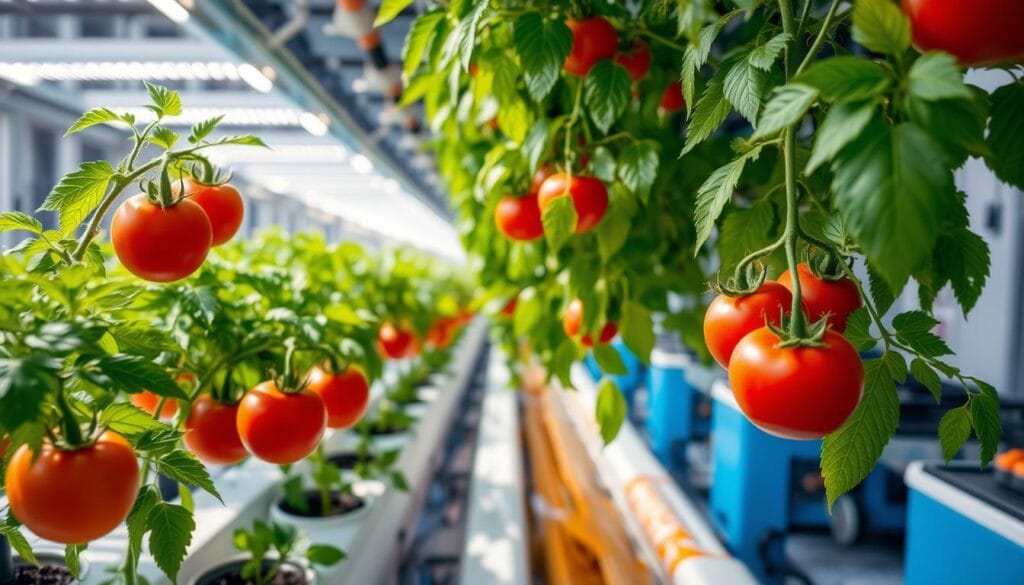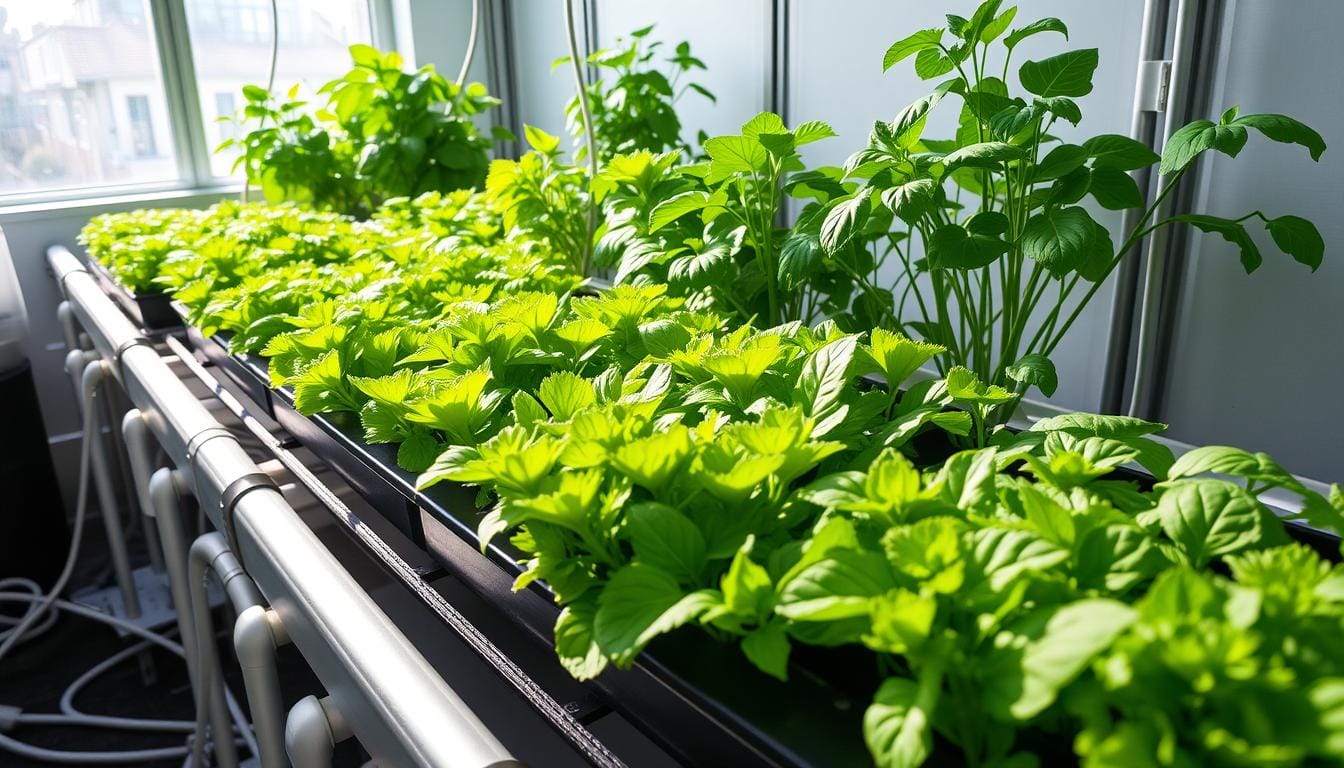Some fast-growing plants for hydroponics are leafy greens, herbs, and microgreens. They grow quickly, ready to eat in 1-3 weeks for microgreens. Leafy greens take about a month to mature.
Hydroponics uses much less water than traditional farming. It’s perfect for places like parking lots or rooftops.
Key Takeaways
- Hydroponic gardening is a soil-less, water-efficient method of growing plants indoors or in limited spaces.
- Fast-growing plants like leafy greens, herbs, and microgreens are ideal for beginner hydroponic growers.
- Hydroponic systems can produce up to 2.7 million servings of leafy greens annually on just 1.5 acres of land.
- Leafy greens and herbs can be harvested in as little as 1-3 weeks for microgreens and about a month for mature plants.
- Hydroponic gardening offers greater control over growing conditions, reduced pests and diseases, and minimized manual labor.
Understanding Hydroponic Growing Systems
Hydroponics is a fascinating way to grow plants that’s becoming more popular. It’s different from growing in soil because it uses water rich in nutrients. This method is great for indoor and year-round gardening.
What is Hydroponics and How it Works
Hydroponics means growing plants without soil. Instead, roots soak in a water solution full of nutrients. This setup gives plants constant water, oxygen, and minerals, helping them grow well in a controlled space.
Benefits of Hydroponic Gardening
Hydroponic gardening has many benefits. Plants grow up to 5 times faster than in soil, and the produce is often better. It also uses up to 90% less water, making it good for the environment. Plus, you can grow plants indoors all year, without worrying about weather.
Essential Equipment for Beginners
To start hydroponic gardening, you need some basic tools. You’ll need a growing medium like coco coir or perlite, a nutrient solution, and a pH testing kit. Depending on your method, you might also need air pumps, grow lights, and water circulation systems.
Whether you’re new to gardening or have experience, hydroponics can be exciting. Learning about it opens up new ways to grow your own food. You can enjoy fresh, healthy produce all year.
Fast-growing Hydroponic Plants for Your Garden
Starting with hydroponics? You’ll find many fast-growing plants that do well without soil. You can grow everything from leafy greens to tasty herbs at home. Let’s look at some fast-growing hydroponic plants great for beginners.
Rex Butterhead lettuce is a top pick for hydroponic lettuce, ready in 6 to 8 weeks. Spinach is quick too, ready in 30 to 40 days. Kale, while a bit harder, can be grown as microgreens or with individual leaves in 50 to 55 days.
Herbs like basil, parsley, and cilantro are also great for hydroponics. Basil takes 65 to 70 days to mature. Parsley and cilantro are ready in 60 to 75 days. These herbs add fresh flavor to your cooking.
Microgreens are another fast option. They’re ready in 1 to 3 weeks. Try growing arugula, kale, or radish for a quick hydroponic project.
Strawberries are also fast-growing hydroponic plants that do well. They produce a lot in just 28 to 42 days. Their small size and vertical growth are perfect for small spaces.
When starting, begin with easy plants like lettuce or green onions. This will help you learn and grow your skills.
Leafy Greens: The Perfect Starter Plants
Leafy greens are great for beginners in hydroponics. They grow fast and are full of nutrients. You can start with hydroponic lettuce, hydroponic spinach, and hydroponic kale. These plants make hydroponics fun and rewarding.
Lettuce Varieties for Quick Harvests
Many lettuce types grow fast in hydroponics. Butterhead lettuce has soft leaves, while green and red oak leaf lettuces are crisp. Romaine lettuce is also good, offering strong leaves for salads and sandwiches.
Growing Spinach and Arugula
Hydroponic spinach and arugula are great for beginners. They grow in 4-6 weeks. Their leaves are full of vitamins and minerals, making them healthy for any meal.
Swiss Chard and Kale Tips
Hydroponic kale and Swiss chard are great for heartier greens. They grow well in hydroponics, offering lots of leaves. Their colors and textures add flavor and beauty to dishes.
| Leafy Green | Ideal pH Range | Harvest Time | Shelf Life |
|---|---|---|---|
| Lettuce | 5.5 – 6.5 | 4-6 weeks | 10-14 days |
| Spinach | 5.5 – 6.5 | 4-6 weeks | 10-14 days |
| Kale | 5.5 – 6.5 | 6-8 weeks | 10-14 days |
| Swiss Chard | 5.5 – 6.5 | 6-8 weeks | 10-14 days |
Leafy greens are perfect for starting in hydroponics. They come in many flavors, colors, and are very nutritious. By knowing how to grow them, you can have a lush hydroponic garden full of fresh food.
Herbs That Thrive in Hydroponic Systems
Many popular herbs like hydroponic basil, parsley, cilantro, dill, mint, and fennel grow well in hydroponic systems. These plants are compact, grow fast, and produce a lot. They are perfect for beginners in hydroponic gardening.
Hydroponic herbs do best in systems with a pH of 5.5 to 6.5 and moderate light. The Nutrient Film Technique (NFT) and Deep Water Culture (DWC) setups are great for them. Basil, for example, loves these conditions and gives you a steady supply of fresh leaves.
These herbs are not just good for cooking. Many have health benefits too. Basil, for instance, has anti-inflammatory properties. Growing them hydroponically means you always have fresh, tasty herbs ready to use.
| Herb | Ideal Hydroponic System | Growth Rate | Health Benefits |
|---|---|---|---|
| Basil | NFT, DWC | 25-50% faster than soil | Anti-inflammatory |
| Parsley | NFT, DWC | 25-50% faster than soil | Rich in antioxidants |
| Cilantro | NFT, DWC | 25-50% faster than soil | Aids digestion |
| Mint | DWC, Flood and Drain | 25-50% faster than soil | Soothing properties |
Using hydroponics lets you have a vibrant herb garden. You’ll enjoy fresh, tasty, and healthy herbs right at home.

Microgreens: The Fastest Growing Option
If you want to add flavor and nutrition to your hydroponic garden, try hydroponic microgreens. They’re ready to eat in just 1-3 weeks. You can grow many tasty varieties like broccoli, radish, arugula, and watercress.
Best Microgreen Varieties for Beginners
For beginners, some microgreens are better than others. Here are a few:
- Broccoli microgreens – Mild in flavor, packed with nutrients
- Pea microgreens – Versatile, sweet, and loved by kids
- Radish microgreens – Spicy and the fastest to mature
- Sunflower microgreens – Sweet and nutritious, great for smoothies
- Purple kohlrabi microgreens – Quick to germinate, mild and perfect for salads
- Clover microgreens – Nutty flavor and high in nutrients
Harvesting and Maintenance Tips
Microgreens reach harvest size once they grow to a height of 1 to 3 inches. This usually takes 7 to 21 days. Ensure their health by supplying adequate light, water, and nutrients. Soaking seeds like peas and sunflowers before planting can help them grow faster.
Nutritional Benefits of Microgreens
Microgreens may be small, but they’re mighty. They have up to 40 times more vitamins, minerals, and antioxidants than full-grown greens. Incorporating them into your meals is an excellent way to boost your health.
| Microgreen Variety | Time to Maturity | Nutritional Highlights |
|---|---|---|
| Broccoli | 7-14 days | High in vitamins C, K, and A |
| Pea Shoots | 10-14 days | Rich in vitamins A, C, and K |
| Radish | 7-12 days | Packed with antioxidants and vitamins |
| Sunflower | 10-14 days | High in protein, iron, and vitamin E |
Discover the power of hydroponic microgreens. They offer a world of fast-growing, nutritious options for your indoor or urban garden.
Quick-Growing Fruiting Plants
Some fruiting plants can be grown hydroponically, but they are harder for beginners. Hydroponic tomatoes, hydroponic strawberries, and hydroponic cucumbers are popular. They need careful attention to pH levels, temperature, and nutrients for the best growth and yield.
Hydroponic tomatoes do well in temperatures between 18-24°C during the day and 13-18°C at night. They also need a slightly acidic environment with a pH of 5.5-6.5.
Hydroponic strawberries are great for saving space because they can grow vertically. They need consistent moisture and a pH of 5.5-6.5 to produce good fruit.
Hydroponic cucumbers grow fast and can be ready in 4-6 weeks. They prefer a pH of 6.0-6.8 and need plenty of space for their vines.
| Crop | Ideal Temperature | Preferred pH Range | Unique Requirements |
|---|---|---|---|
| Hydroponic Tomatoes | 18-24°C (day), 13-18°C (night) | 5.5-6.5 | Careful pH monitoring |
| Hydroponic Strawberries | Varies by variety | 5.5-6.5 | Vertical stacking for space efficiency |
| Hydroponic Cucumbers | Varies by variety | 6.0-6.8 | Ample space for vining growth |

While they are harder for beginners, growing hydroponic tomatoes, hydroponic strawberries, and hydroponic cucumbers can be rewarding. With the right setup and care, these plants can thrive and give a big harvest.
Essential Growing Conditions and Nutrients
Successful hydroponic gardening depends on managing key growing conditions and nutrients. Factors like pH levels, water quality, lighting, temperature, and humidity are crucial. Each plays a vital role in ensuring plants grow well and produce high yields.
pH Levels and Water Quality
Keeping the pH level between 5.5 and 6.5 is essential for hydroponics. This range helps plants absorb nutrients from the solution. It’s important to regularly check and adjust the pH to keep plants healthy. Also, using clean water is key, as impurities can harm plant health.
Lighting Requirements
Hydroponic plants need 10 to 16 hours of light daily. The type and intensity of light depend on the plant. LED grow lights are a good choice for their energy efficiency and versatility. Providing the right light is vital for plant growth.
Temperature and Humidity Control
Temperature and humidity are critical in hydroponics. Most plants thrive at temperatures between 18°C and 24°C, so it’s essential to monitor and adjust these conditions as necessary. The right humidity level is also key, as too much can cause disease, while too little can stress plants.
| Parameter | Optimal Range |
|---|---|
| pH | 5.5 – 6.5 |
| Lighting | 10 – 16 hours per day |
| Temperature | 18°C – 24°C |
| Humidity | Optimal humidity levels vary by plant species |
By monitoring and maintaining these conditions, you can create a thriving hydroponic garden. Proper nutrient management, along with these environmental factors, is crucial for success in hydroponic growing.
Common Challenges and Solutions
Starting a hydroponic garden is rewarding but comes with challenges. Beginners might face issues like nutrient imbalances, pH level changes, and pests. But, with the right knowledge and actions, you can solve these problems and grow a healthy garden.
Keeping the right nutrient levels in your system is key. Regularly test and adjust the nutrient solution to ensure your plants get what they need. Without this, your plants might not grow well, change color, or even die.
Monitoring your system’s pH is also crucial. Most plants prefer a pH between 5.5 and 6.5. If the pH changes too much, it can affect how plants absorb nutrients. Testing and adjusting the pH regularly helps keep your plants healthy.
Pests can also be a problem in hydroponic gardens. Without soil, plants are more vulnerable to pests like aphids and spider mites. Using beneficial insects or natural repellents can help control pests and keep your plants healthy.
By watching your system closely and fixing problems quickly, you can overcome common hydroponic challenges. Keeping your system clean, well-maintained, and properly ventilated helps prevent many issues.
For beginners, starting with simple systems like wick or water culture is a good idea. These systems are easier to manage and can help you learn without getting overwhelmed. As you gain experience, you can move to more complex systems like NFT or ebb and flow, which offer more control.
| Hydroponic System | Ideal for | Key Benefits |
|---|---|---|
| Wick System | Herbs, Microgreens | Simple, Low-maintenance |
| Deep Water Culture (DWC) | Larger Plants (Tomatoes, Peppers) | Faster Growth, Abundant Harvests |
| Nutrient Film Technique (NFT) | Leafy Greens, Herbs | Precise Nutrient Control, Space-efficient |
| Ebb and Flow | Wide Range of Plants | Versatile, Automated Watering |
Understanding and tackling common hydroponic challenges can lead to a thriving indoor garden. With the right techniques and patience, your hydroponic journey can be a success.
Conclusion
Hydroponic gardening saves water, grows food all year, and produces a lot in small spaces. This method consumes up to 90% less water compared to traditional farming. This makes hydroponics a great choice for many places, like schools and zoos.
Starting or already growing with hydroponics can be very rewarding. You can grow many plants quickly and healthily. This includes leafy greens, herbs, and fruits, all without using many pesticides.
Hydroponics is getting better and easier to use. It could help solve food shortages and support green farming. By using hydroponics, you help make food systems better and grow your own food all year.

